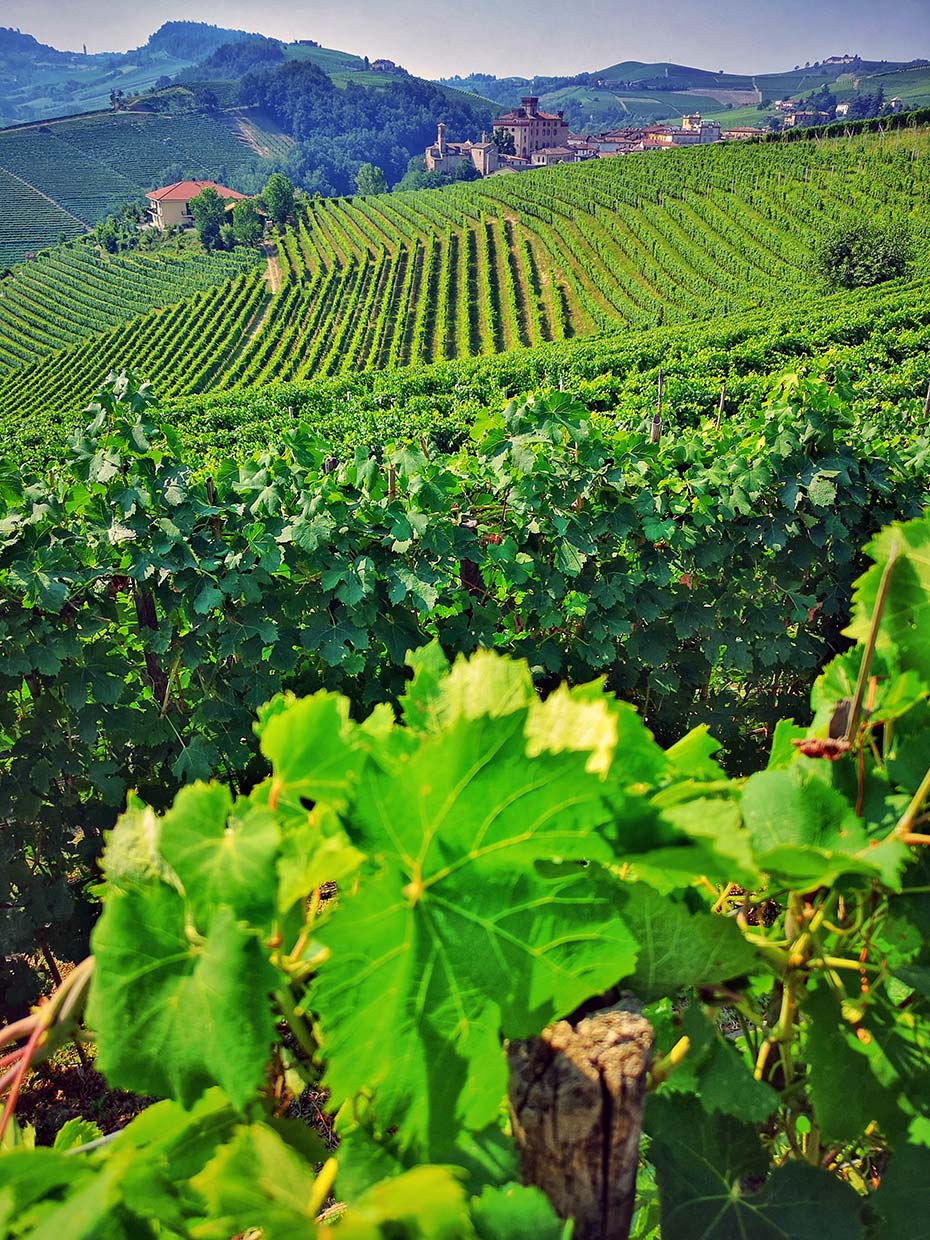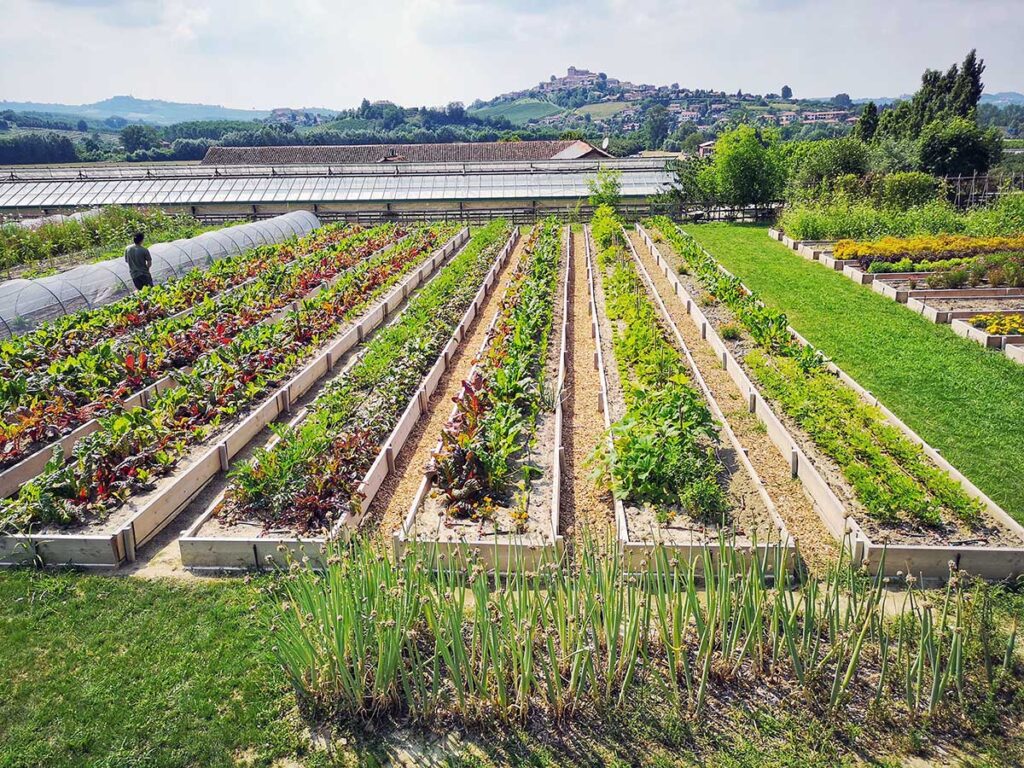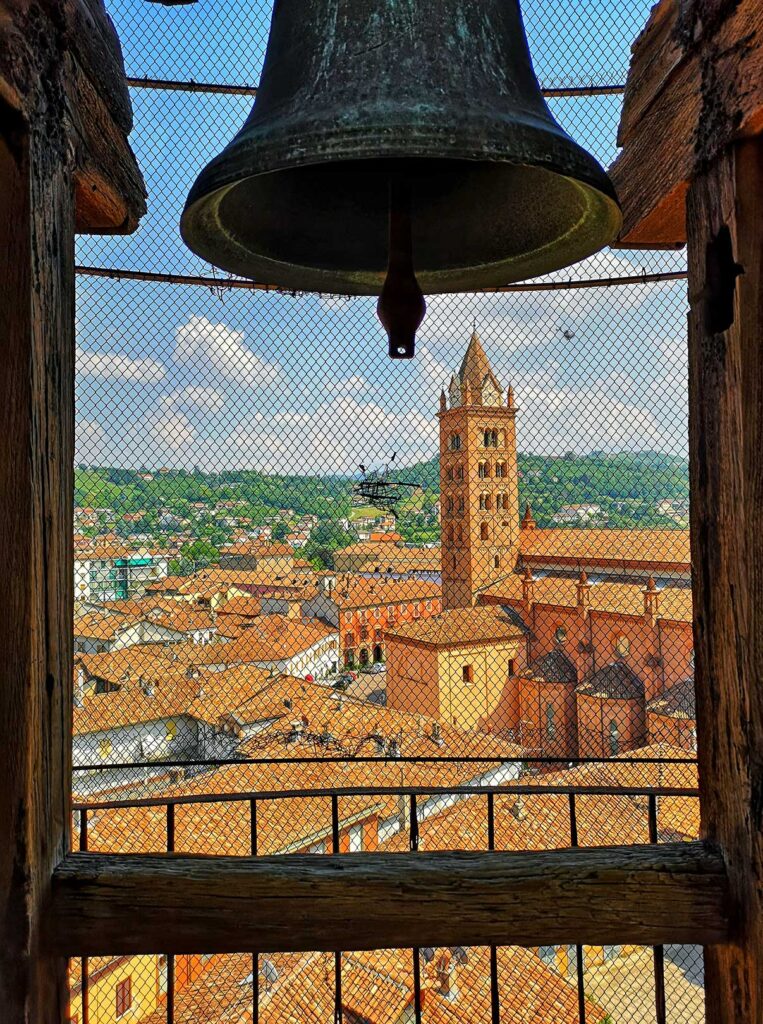With the re-opening of restaurants in Italy, Alba’s very own Piazza Duomo is also back on. Gastronomy writer Kaja Sajovic reminisces about the dolce vita she experienced at Alba with the perfume of hazelnuts, the lingering notes of Ceretto Barolo and truffles, and the gastronomic finale with chef Enrico Crippa’s Piazza Duomo.

First it’s the smell of Nutella that wakes you up. Then the ringing of church bells from the nearby duomo. Or is it the other way around?
I guess it’s a mix of both, and they intertwine with the bright yellow-hued light that peers through the large window of my Piazza Duomo boutique, 4-rooms kind of boutique hotel overlooking the quaint alley bellow. This is Alba, the very center of so many prime produce that it’s hard to believe it’s all set in a super tiny Piedmontese town of no more than 30.000 inhabitants.
White truffles, Barolo and Barbaresco wines, peaches, “Fassone” veal and the revered Piedmontese hazelnuts that in 1946 gave birth to the mastodon of chocolate and confectionary manufacturers that Ferrero has become.
The company founded by Pietro Ferrero who invented gianduja (hazelnut and cocoa spread) now employs one fifth of the town’s population and the hazelnuts they use for Nutella, giandujas, Ferrero Rochers, Raffaellos and other products have long been surpassed and almost completely replaced by imports from Turkey and North Africa, but Alba remains their headquarters. And yes, they still make Nutella every morning before dawn, hence the strong sweet, nutty aromas that creep up your bedroom window.
The town itself is surprisingly quiet and laid back for a place that boasts such a bounty of eno-gastronomical treats. There are a few tourists sipping on Aperol-Spritz in the only bar on the town’s main square, there are gypsies setting out their merchandise under the medieval arcades and around the corner there are local farmers, cheese and soft salami producers who are sticking out small morsels of their produce to passersby at the Saturday market.
But yes, there are reminders everywhere that you are in truffle country – even though they weren’t really in season at the time I was there. These precious mushrooms were popping out of every second shop window display, in all shapes and sizes.
This is where the most expensive white truffle ever was found and sold for 120.000 US dollars. This is where every November they do a truffle auction that draws in Asian millionaires, and this is where Enrico Crippa runs his 3 Michelin starred restaurant, the acclaimed Piazza Duomo, world’s 29th restaurant according to 50 Best list, that attracts foodies from all over the world to this unassuming town.
General view of Alba from the bell tower.
Ceretto Winery
The owner of the restaurant (and the small imperium that goes with it) is not the moustachy chef though, but the extremely well-off Ceretto family, winemaking family who, besides owning a couple of impressive wineries in the region also presides over Piazza Duomo and its casual bistro-style La Piola where they aim to showcase the very best of Piedmontese ingredients. Oh, and since they are, naturally, huge patrons of art, they frequently host prominent artists, musicians and performers, the likes of Marina Abramovic, Patti Smith and Bob Dylan.
Cerettos have thus every reason to be a stuck-up dynasty, detached from the commoners, but they are anything but. Roberta Ceretto that shows us around the vineyards is one of those effortlessly chic, elegant, slender Italian women who are equally good at explaining the winemaking process in great depth and sitting at the front row of Milan fashion week. We follow her as she climbs the steep hill of Barolo where her family’s oldest vineyards grow with vines dating back to 1920s. The views are magical, stretching to Barbaresco on the other side of the valley and to random castles that pop up here and there in the middle of sea of green.

Cerettos own a whooping 160 hectares of vineyards (and hazelnuts) all together, both in Barolo and Barbaresco. In 2010 they started implementing organic approach on all the vineyards and hazelnut groves and stricter biodynamical principles in Barolo and Barbaresco. Today all their cru (20 hectares) are treated biodynamically and their plan for the future is to apply it to all of their vineyards – note, this is an area where organic winemaking is really not so common, so they are really one of the rare ones that dabble in sustainable winemaking.
As they say, here it’s all about the position, not really the winemaker. Position is key. Every hill has its own name, every position his. And there’s always a certain history, a story linked to it. Cerettos do produce also white wine, but, as Roberta explains, these are mostly drunk here “like water” whereas with big, full-bodied reds like Barolo you need a story, you need to link the wine with food, with history, with tradition.
It’s not hard to find all of the above here in this region that’s often referred to as more low-key Tuscany. This is where formerly Italian capital was set (Turin), where Slow Food movement began (Bra) and where, in 14th century, in the tiny town of Cherasco, Duke of Clarence died due to truffle indigestion – which is probably the most bad-ass hedonistic cause of death I have heard of.
In Langhe, which is where most of Cerettos’ vineyards are planted, you’ll find two of their most impressive vineyard structures that have become some sort of emblems of Barolo region over the recent years – the dome overlooking the vineyards at Monsordo Bernardina Estate and “The Cube” set in Bricco Rocche Winery. But even bigger attraction has completely inadvertently become the old chapel of Our Lady of Grace in Brunate Vineyard in La Morra that Cerettos purchased in 1976 and in 1999 commissioned artists Sol LeWitt and David Tremlett to paint it in bright, South American inspired colors. The chapel has since become an icon of the region and a popular stop on every Barolo tour.
Enter Piazza Duomo
Chef Crippa moved here from nearby region of Lombardy in the early 2000s when star chef Carlo Cracco introduced him to Ceretto family who, at the time, were looking for a skilled chef for their fine dining restaurant. Crippa, quiet, a bit introverted but quirky chef with a delicate touch and a huge perfectionist turned out to be the perfect fit. They opened the restaurant in 2005 and in 2012 they got the third star.
And the meal, the moment you walk through those crimson doors with “Piazza Duomo” etched in gold, and sit in the bright pink dining room, under the elk frescos, is an exercise in style. “Ready to get drunk?” asks Vincenzo Donatiello, Piazza’s manager and head sommelier in all seriousness. He pours us the champagne, sets hazelnut (but of course) bread rolls in front of us and starts the dinner service that would end more than four hours later. What did I say about this being the birthplace of Slow Food movement?
Piazza Duomo’s stand-out entrance and Chef Enrico Crippa.
Appetizers come rolling out – shells of caviar and cream with clear cod fish broth, peanut cracker with foie gras and Campari foam, leaves of endive with burrata and edamame.
Then on to the first course, cucumber milk with fresh almonds and spring onions with delicious porchetta sandwich – cute, witty touch to start of the meal that was anything but casual. For his menu Crippa works hand in hand with his gardener, also named Enrico, and vegetables, microgreens and herbs grown in their gorgeous green house and garden really are often the stars of Piazza tasting menu. “365 days a year the garden is constantly evolving and I’m evolving with it – there are plants and crops that last only for a week and others that last much longer. My creativity is linked to the passing of time in our garden,” explains the chef.
Case in point: Crippa’s signature dish, named “Salad 21…31…41…51”. It’s a bowl of salad containing, depending of the season, everything from 30 to almost unbelievable 110 elements. Everything from nori algae to yerba Buena, from ginger to dog rose, from orchid to chocolate mint … There’s two kinds of sesame, 4 kinds of mustard leaves, 4 kinds of basil, 5 kinds of sorrel, there’s pea petals, Jamaican oregano, fennel, lamb lettuce, carrots, stevia, wasabi, marigold, nasturtian flowers, radicchio, pak choi flowers, oxalis, lemon flowers, two kinds of shiso, lemon thyme … of course there are hazelnuts as well and vinegar made of Barolo, olive oil dressing with tuna dashi.

And from then on there’s really no stopping Crippa, who is definitely not a minimalist when it comes to plates – there’s sea urchin carpaccio, then comes the beetroot in 4 forms, one being a fluffy pink-hued tramezzino, and mackerel that’s served with 4 extra tiny plates on which baby veggies from the garden are highlighted, prawns and carrots are composed of 4 small plates and red mullet with baby zucchini and curry is wonderfully paired with Gravner ribolla from 2003.
There’s cod with ginger and cod reduction, there’s Crippa’s vision of “pizzaiola”, there’s burnt lemon risotto that comes with blind wine tasting and there’s the grand finale in shape of pigeon with spices – and Barolo, naturally. We finish the dinner well after midnight, with the signature, colorful and artsy “Panna cotta Matisse” that pays homage to the French expressionist.
“100% Alba”, is written on the back of the T-shirts and on baseball caps the kitchen team, Crippa included wear religiously. Having spent a few days in Alba, I can attest to the fact that the place has a strong feeling of identity and soul. And Piazza Duomo seems to fit in this beautiful collage of arts, history and abundance of natural resources. “Whoever comes here to Piazza Duomo needs to feel Alba in the plates, he or she needs to know exactly where he or she is,” says Crippa. And I kind of did.






